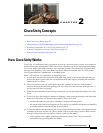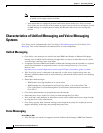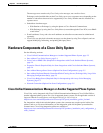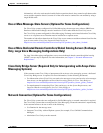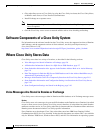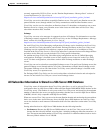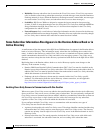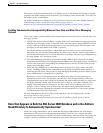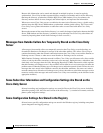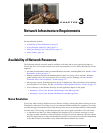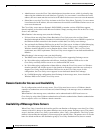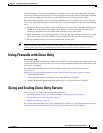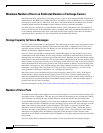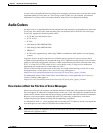
2-8
Design Guide for Cisco Unity Release 5.x
OL-14619-01
Chapter 2 Cisco Unity Concepts
Where Cisco Unity Stores Data
• Reliability: Because subscriber data is stored on the Cisco Unity server, Cisco Unity can answer
calls, let outside callers look up subscriber extensions, and take messages even when the Domino or
Exchange network is down. (When the Domino or Exchange network is unavailable, new messages
are stored on the Cisco
Unity server, and subscribers have access to those messages.)
• Scalability: SQL Server 2000 was designed to support the largest enterprise data processing
systems, so there is more than enough room for storing the Cisco
Unity data. Although MSDE has
storage limitations that SQL Server does not, it is also more than adequate for the Cisco
Unity
configurations for which it is sold.
• Network Impact: Only a small subset of subscriber information needs to be stored in the directory,
and that information does not change frequently. Therefore, directory replication caused by changes
to Cisco
Unity data is minimal after subscriber accounts have been created.
Some Subscriber Information Also Appears in the Domino Address Book or in
Active Directory
A small amount of data that appears in the SQL Server 2000 database also appears in the Domino address
book or in Active Directory. This information, mostly subscriber data (including the recorded voice
name), is added to the directory to enable Cisco
Unity servers to communicate with one another and to
enable communication between Cisco
Unity and other voice messaging systems. Cisco Unity uses a
directory monitor to keep the data in the directory synchronized with the data in the SQL Server 2000
database.
Replicating data to the Domino address book or to Active Directory requires some changes to the
directory. If the customer is using:
• Domino, IBM Lotus Domino Unified Communications (DUC) for Cisco must be installed on the
Domino servers that will home Cisco
Unity subscribers. This adds elements to the address book. In
addition, DUC for Cisco must be installed on the client workstation for each Cisco
Unity subscriber,
which adds elements to the mail file for the client.
• Exchange, the Active Directory schema must be extended with a few Cisco Unity–specific
attributes. For information about the Active Directory schema extensions, see the applicable
Cisco
Unity Data and the Directory white paper at
http://www.cisco.com/en/US/products/sw/voicesw/ps2237/prod_white_papers_list.html.
Enabling Cisco Unity Servers to Communicate with One Another
When two or more Cisco Unity servers are added to the same Domino address book or Active Directory
forest, each Cisco
Unity server serves a distinct group of subscribers. You can optionally configure the
Cisco
Unity servers to communicate with one another, which lets you administer subscriber accounts on
all Cisco
Unity servers from a single location and lets callers leave messages for any subscriber,
regardless of the Cisco
Unity server with which the subscriber is associated.
If you configure multiple Cisco Unity servers to communicate with one another, two types of
Cisco
Unity data are stored in the directory:
• A primary location object for each Cisco Unity server. This unique identifier contains the addressing
information that Cisco
Unity needs to route messages to other Cisco Unity servers. The directory
contains one primary location object for each Cisco
Unity server in the Domino domain or Active
Directory forest.
• Selected subscriber data. The stored properties include the Cisco Unity server with which each
subscriber is associated, the subscriber extension, and a recording of the subscriber name.




